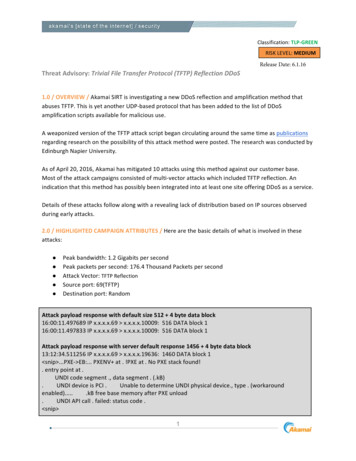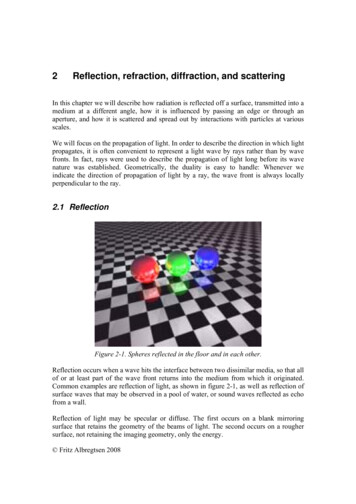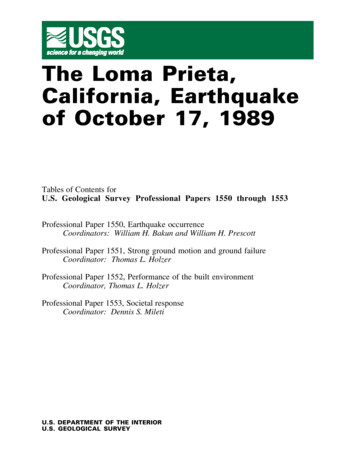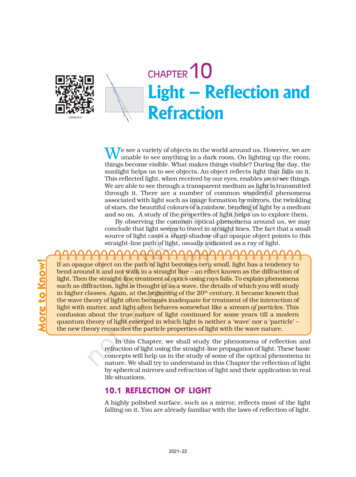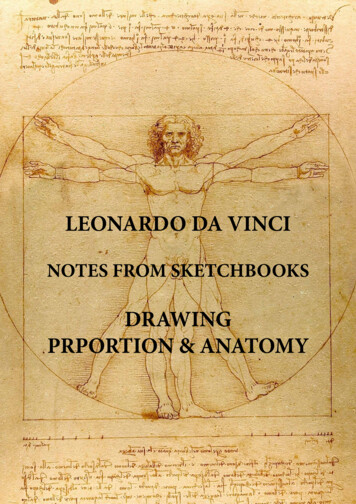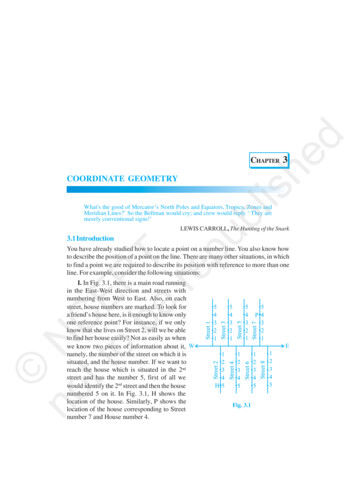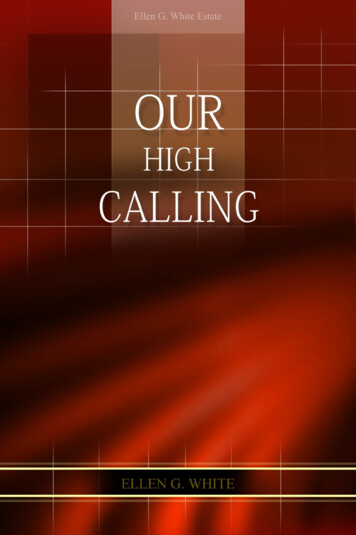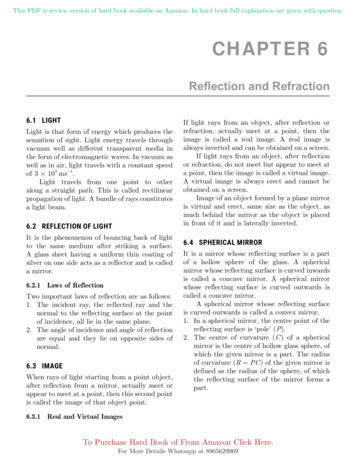
Transcription
This PDF is review version of hard book available on Amazon. In hard book full explanation are given with question.Chap 6Reflection and Refraction Page 157 CHAPTER6 Reflection and Refraction6.1 LightLight is that form of energy which produces thesensation of sight. Light energy travels throughvacuum well as different transparent media inthe form of electromagnetic waves. In vacuum aswell as in air, light travels with a constant speedof 3 # 108 ms-1 .Light travels from one point to otheralong a straight path. This is called rectilinearpropagation of light. A bundle of rays constitutesa light beam.6.2 Reflection of LightIt is the phenomenon of bouncing back of lightto the same medium after striking a surface.A glass sheet having a uniform thin coating ofsilver on one side acts as a reflector and is calleda mirror.6.2.1 Laws of ReflectionTwo important laws of reflection are as follows:1. The incident ray, the reflected ray and thenormal to the reflecting surface at the pointof incidence, all lie in the same plane.2. The angle of incidence and angle of reflectionare equal and they lie on opposite sides ofnormal.6.3 ImageWhen rays of light starting from a point object,after reflection from a mirror, actually meet orappear to meet at a point, then this second pointis called the image of that object point.If light rays from an object, after reflection orrefraction, actually meet at a point, then theimage is called a real image. A real image isalways inverted and can be obtained on a screen.If light rays from an object, after reflectionor refraction, do not meet but appear to meet ata point, then the image is called a virtual image.A virtual image is always erect and cannot beobtained on a screen.Image of an object formed by a plane mirroris virtual and erect, same size as the object, asmuch behind the mirror as the object is placedin front of it and is laterally inverted.6.4 Spherical mirrorIt is a mirror whose reflecting surface is a partof a hollow sphere of the glass. A sphericalmirror whose reflecting surface is curved inwardsis called a concave mirror. A spherical mirrorwhose reflecting surface is curved outwards iscalled a concave mirror.A spherical mirror whose reflecting surfaceis curved outwards is called a convex mirror.1. In a spherical mirror, the centre point of thereflecting surface is ‘pole’ (P).2. The centre of curvature (C ) of a sphericalmirror is the centre of hollow glass sphere, ofwhich the given mirror is a part. The radiusof curvature (R PC ) of the given mirror isdefined as the radius of the sphere, of whichthe reflecting surface of the mirror forms apart.6.3.1 Real and Virtual ImagesTo Purchase Hard Book of From Amazon Click Here.For More Details Whatsapp at 8905629969
For Answer and Explanation Question Click the Link in Pink Color.Page 158Reflection and Refraction3. Principal axis is the line passing through poleP and centre of curvature C of a mirror. Thediameter of reflecting surface of a sphericalmirror is called its aperture.4. The principal focus (F ) of a spherical mirroris a point on its principal axis where lightrays travelling parallel to the principal axisof the mirror, after reflection, actually meet(in concave mirror) or appear to meet (inconvex mirror). Principal focus of a concavemirror is a real point situated in front of themirror and of a convex mirror is a virtualpoint situated behind it.5. The distance between pole P and principalfocus F of a spherical mirror is focal length(f ), i.e., PF f . For a spherical mirror,f R2R 2fChap 66. Focal plane is a plane passing throughprincipal focus and normal to the principalaxis of a mirror.7. The position, nature and relative size ofimage formed by a concave mirror dependupon the position of the object situated infront of the mirror as shown in the followingtable.Formation of image by a concave mirror fordifferent positions of the objectPositionof theobject1. Atinfinity2. BeyondCPositionof theimageRelativesize of theimageNature ofthe imageAt thefocusHighlydiminished(pointsized)Real andinvertedBetweenF andDiminishedReal andinverted(F )CTo Purchase Hard Book of From Amazon Click Here.For More Details Whatsapp at 8905629969
This PDF is review version of hard book available on Amazon. In hard book full explanation are given with question.Chap 6Reflection and Refraction Page 159Positionof theobject3. At C4. BetweenC andF5. AtF6. BetweenP andFPositionof theimageRelativesize of theimageNature ofthe imageAt CSame sizeas theobjectReal andinvertedBeyondEnlargedReal andinvertedAtinfinityHighlyenlargedReal andinvertedBehindthemirrorEnlargedVirtualand erectCsharp turns and as shop security mirrors inlarge shopping halls and malls.6.5 Sign conventionAccording to new Cartesian sign conventionfor mirrors, all distances are measuredfrom the pole of the mirror and object isalways situated to the left of the mirror.Pole is considered as origin for measuringdistances along principal axis. All distancesmeasured to the right of origin along theprincipal axis are taken positive and to theleft of origin are taken negative.8. A convex mirror forms a virtual, erect anddiminished image of an object situated infront of it as shown in the following table.Formation of image by a convex mirror fordifferent positions of the objectPositionof theobjectPosition of Relativethe image size of theimageNatureof theimage1. AninfinityBehindthe mirrorat thefocus FHighlydiminished(pointsized)Virtualanderect2. Betweeninfinityand poleP of themirrorBehindthe mirrorbetweenP and FDiminished Virtualanderect9. Concave mirrors are used as shaving andmake-up mirrors to see a large-sized erectimage of the face. They are used as reflectorsin torches, searchlights and headlights ofvehicles to get powerful parallel beam of light.They are used by dentists to see large imagesof a patient’s teeth. Eye and ENT specialistsalso use these mirrors to focus light comingfrom a lamp onto the eye, ear, nose, throat,etc., of a patient in order to examine better.They are used to concentrate the sun’sradiation to a point in a solar furnace.10. Convex mirrors are used as driver’s mirrorsin vehicles in order to have a wider field ofview for traffic coming from behind. Theyare also used as reflectors in hilly areas atAlong a direction perpendicular to principalaxis, distances measured above the principalaxis are taken positive but below the principleaxis are taken negative.6.6 Mirror formulaIf object distance u , image distance vand focal length f , then according to mirrorformula, we have1 1 1 or 2 , where R Radius ofv uRfcurvature of the mirrorOn putting numerical values of u, v f orR, proper sign must be used according to signconvention.6.7 Linear magnificationThe ratio of height of the image (hl) to theheight of the object (h) is linear magnificationTo Purchase Hard Book of From Amazon Click Here.For More Details Whatsapp at 8905629969
For Answer and Explanation Question Click the Link in Pink Color.Page 160Reflection and Refractionof an object, i.e.,m hl vuhLinear magnification is negative for realimage but positive for virtual image. If image ismagnified, m 1 and if diminished, m 1.For plane mirror, m 1.6.8 Refraction of lightIt is the phenomenon of the change in direction/bending of a ray of light incident obliquely atthe interface of two different transparent media.1. When light travels from optically densermedium to rarer medium, it bends awayfrom normal.2. When light travels from optically rarermedium to denser medium, it bends towardsthe normal.6.8.1 Laws of RefractionTwo important laws of refraction are as follows:1. The incident ray, the refracted ray and thenormal to the interface of two media at thepoint of incidence, all lie in the same plane.2. The ratio of sine of angle of incidence (sin i)to the sine of angle of refraction(sin r) isa constant for light of a given colour orwavelength and for a given pair of media.This law is called Snell’s law of refraction.As per the law,sin i a constantsin r (n21) (Refractive index of med.2 w.r.t. med. 1)6.9 Refractive index of a mediumThe ratio of speed of light in vacuum (or air)to speed of light in the given medium is calledrefractive index of a medium.Refractive index,Speed of light in vacuum (air)n Speed of light in the given medium cvChap 6It is a unit-less quantity and its numericalvalue is 1 or greater than 1. For vacuum and air,n 1.1. If a light ray is refracted from medium 1 tomedium 2, then refractive index of medium 2w.r.t. medium 1 (n21) is defined as the ratioof speed of light in medium 1 (v1) to speed oflight in medium 2 (v2).So, refractive index of medium 2 w.r.t.medium 1,n21 v1v2orn21 v1 n2v2n1Therefore, n12 1n212. Relative refractive index of one medium w.r.t.another medium too is a unit-less quantityand its numerical value may be equal to 1 orgreater than 1 or even less than 1.3. The refractive index of vacuum is calledabsolute refractive index.4. If a ray of light is refracted through arectangular glass slab, the angle of emergenceis same as angle of incidence. Hence, emergentray travels in a direction parallel to that ofincident ray.But, the ray suffers a lateral displacementwhose value is based on (i) thickness of theglass slab, (ii) refractive index of the glassslab, and (iii) angle of incidence. For angle ofincidence ( i) 0c, the lateral displacementis also zero (0).5. Due to refraction of light, a pencil immersedin water in a glass tumbler appears to bedisplaced at water-air interface. When aglass slab is placed over some printed matter,words appear raised up when observed orseen through the glass slab.6. If a coin is placed at the bottom of a tumblerfilled with water, the apparent depth of thecoin appears to be less than its true depthbecause of refraction of light.Therefore,Real depth (h) Refractive indexApparent depth (hl)To Purchase Hard Book of From Amazon Click Here.For More Details Whatsapp at 8905629969
This PDF is review version of hard book available on Amazon. In hard book full explanation are given with question.Chap 6Reflection and Refraction Page 161of water (nw)For similar reason, a pond of water appearsto be shallower.a lens, parallel beam of light may be incidenton any of its two surfaces having two principalfoci F1 and F2 , placed symmetrically on twosides of a lens.6.10 LensIs is a part of refracting material, i.e., glass,bound by two non-parallel surfaces, of whicheither both or one surface is spherical.A lens thicker at the middle and thinner atthe edges is known as a convex (converging) lens.A lens thicker at the edges and thinner atthe middle is known as a concave (diverging)lens.1. A lens contains two centres of curvature andtwo radii of curvature as shown in the figure.2. Principal axis is a line passing through twocentres of curvature of a lens.3. The optical centre of a lens is the point on itsprincipal axis, a ray of light passing throughwhich goes undeviated. It is the centre of thelens.4. A point where a light beam travellingparallel to the principal axis of the lens, afterrefraction, actually meets in convex lens orappears to be diverged from in concave lensis called principal focus (F ) of the lens. As, in5. Focal length (f ) is the distance of principalfocus from optical centre of a lens.6. Focal plane is a plane passing throughprincipal focus and perpendicular to theprincipal axis of a lens.The position, nature and size of the imageformed by a convex lens are based upon theposition of the object placed in front of thelens as mentioned in the following table.Formation of image by a convex lens fordifferent positions of the objectTo Purchase Hard Book of From Amazon Click Here.For More Details Whatsapp at 8905629969
For Answer and Explanation Question Click the Link in Pink Color.Page 162Reflection and RefractionPositionof theobjectPositionof theimageRelativesize of theimageNature ofthe image1. AtinfinityAt focusHighlydiminished(pointsized)Real andinverted2. BeyondBetweenF2 andDiminishedReal andinvertedSame sizeas theobjectReal andinverted2F13. At2F1F22F2At2F24. BetweenF1 andBeyondEnlargedReal andinverted5. At focusAtinfinityInfinitelylarge(highlyenlarged)Real andinverted6. BetweenfocusF1 andopticalcentre OOn thesameside ofthe lensas theobjectEnlargedVirtualand erect2F1F12F27. A concave lens always forms a virtual, erectand diminished image of the object on thesame side of the lens as mentioned in thefollowing table:Formation of image by a concave lens fordifferent positions of the objectPositionof theobjectPosition of Relativethe image size of theimageNatureof theimage1. AninfinityAt focusHighlydiminished(pointsized)2. BetweeninfinityandopticalO of thelensBehindfocusF1 andopticalcentre ODiminished VirtualanderectF1VirtualanderectChap 6The sign convention for lenses is same asthat for mirrors except the optical centre ofthe lens which is taken to be the origin point.If object distance u , image distance vand focal length f , then from the lensformula, we have1-1 1v uf9. For a linear object placed normal to theprincipal axis of a spherical lens, linearmagnification of a lens is stated as follows:Linear magnification of a lens,Height of the (hl)m Height of the object (h)Distance of the image (v) Distance of the object (u)Linear magnification is negative for a realimage but positive for a virtual image.6.11 Power of a LensIt is a measure of its degree of convergence ordivergence of light rays incident on it. It is alsodefined as reciprocal of its focal length.Power of a lens,1(P) Focal length of the lens (in metre)1 f (in m)The SI unit of power of a lens is dioptre (D),where 1 D 1 m 1 .The power of convex lens is taken positivebut power of concave lens is taken negative.1. When two or more thin lenses of powersP1, P2, P3, . are brought in contact, thenCombined power,P P1 P2 P3 .1 1 1 1 .ff1 f2 f3 ******8. Lenses are used in spectacles, different opticalinstruments such as microscope, telescope,photographic camera, film projector, etc.To Purchase Hard Book of From Amazon Click Here.For More Details Whatsapp at 8905629969
This PDF is review version of hard book available on Amazon. In hard book full explanation are given with question.Chap 6Reflection and Refraction Page 163 mulitiple choice QUESTION1.What is the frequency of violet colour ofc?wavelength 4000 A10(a) 7.5 # 10 Hz(b) 7.5 # 1012 Hz(c) 7.5 # 1014 Hz(d) 3.75 # 1016 Hz(a)(b)(c)(d)5.Don’t Take Printout of This File becausethis is not useful. You can purchase hardbook from Amazon. Hard book includesexplanation of all MCQs in print form.What is the frequency of red colour ofc?wavelength 8000 A(a) 3.75 # 1014 Hz(b) 3.75 # 1012 Hz(c) 3.75 # 1016 Hz(d) none of theseLight enters from air to glass havingrefractive index 1.50. The speed of light invacuum is 3 # 108 ms-1 . The speed of lightin the glass is(a) 2 # 108 ms-1(b) 3 # 108 ms-1(c) 4 # 10 4 ms-1(d) 5 # 105 ms-1Sol : www.cbse.site/sc/gm102Sol : www.cbse.site/sc/gm106The refractive index of glass is 3/2. Thevelocity of light in glass is(a) 3 # 108 m/s(b) 2 # 108 m/s(c) 108 m/s(d) 1.33 # 108 m/s7.Sol : www.cbse.site/sc/gm1034.A concave mirror produces three timesmagnified (enlarged) real image of anobject placed at 10 cm in front of it. Whereis the image located?(a) 30 cm(b) 40 cm(c) - 30 cm(d) - 40 cmSol : www.cbse.site/sc/gm1056.3.cmcmcmcmSol : www.cbse.site/sc/gm104Sol : www.cbse.site/sc/gm1012.10203040The radius of curvature of a sphericalmirror is 20 cm. the focal length of mirroris-A convex lens forms a real and invertedimage of a needle at a distance of 50 cmfrom it. Where is the needle placed in frontof the convex lens if the image is equal tothe size of the object?(a) 0.25 m(b) 0.30 m(c) 0.35 m(d) 0.40 mSol : www.cbse.site/sc/gm1078.The power of a concave lens of focal lengthTo Purchase Hard Book of From Amazon Click Here.For More Details Whatsapp at 8905629969
For Answer and Explanation Question Click the Link in Pink Color.Page 164of 2(a)(b)(c)(d)Reflection and Refractionm is0.5 D- 0.5 D1D-1 DSol : www.cbse.site/sc/gm1089.Which one of the following materials cannotbe used to make a lens?(a) Water(b) Glass(c) Plastic(d) ClaySol : www.cbse.site/sc/gm10910. The image formed by a concave mirror isobserved to be virtual, erect and larger thanthe object. Where should be the position ofthe object?(a) Between the principal focus and thecentre of curvature(b) At the centre of curvature(c) Beyond the centre of curvature(d) Between the pole of the mirror and itsprincipal focus.Sol : www.cbse.site/sc/gm110Chap 6have each a focal length of - 15 cm . Themirror and the lens are likely to be(a) both concave(b) both convex(c) the mirror is concave and the lens isconvex(d) the mirror is convex, but the lens isconcaveSol : www.cbse.site/sc/gm11213. No matter how far you stand from a mirror,your image appears erect. The mirror islikely to be(a) Plane(b) Concave(c) Convex(d) Either plane or convexSol : www.cbse.site/sc/gm11314. Which of the following lenses would youprefer to use while reading small lettersfound in a dictionary?(a) A convex lens of focal length 50 cm.(b) A convex lens of focal length 50 cm.(c) A convex lens of focal length 5 cm.(d) A concave lens of focal length 5 cm.Sol : www.cbse.site/sc/gm11411. Where should an object is placed in frontof a convex lens to get a real image of thesize of the object?(a) At the principal focus of the lens(b) At twice the focal length(c) At infinity(d) Between the optical centre of the lensand its principal focus.Sol : www.cbse.site/sc/gm11112. A spherical mirror and a thin spherical lens15. A concave lens of focal length 15 cm formsas image 10 cm from the lens. How far isthe object placed from the lens?(a) - 20 cm(b) 40 cm(c) - 30 cm(d) - 40 cmSol : www.cbse.site/sc/gm11516. An object is placed at a distance of 10 cmTo Purchase Hard Book of From Amazon Click Here.For More Details Whatsapp at 8905629969
This PDF is review version of hard book available on Amazon. In hard book full explanation are given with question.Chap 6Reflection and Refraction Page 165from a convex mirror of focal length 15 cm.the position of the image is(a) 6 cm(b) 9 cm(c) 8 cm(d) 7 cmof power 1.5 D . The focal length of thelens is(a) 67 cm(b) 70 cm(c) 40 cm(d) 65 cmSol : www.cbse.site/sc/gm116Sol : www.cbse.site/sc/gm12017. An object 5.0 cm in length is placed ata distance of 20 cm in front of a convexmirror or radius of curvature 30 cm. Theposition of the image is(a) 8.57 cm(b) 9.10 cm(c) 8.15 cm(d) 7.15 cm21. The angle between incident ray andreflected ray is 60c. What is the angle ofincidence?(a) 30c(b) 40c(c) 60c(d) 50cSol : www.cbse.site/sc/gm121Sol : www.cbse.site/sc/gm11718. An object of size 7.0 cm is placed at 27 cmin front of a concave mirror of focal length18 cm. At what distance from the mirrorshould a screen be placed, so that a sharpfocussed image can be obtained?(a) 54 cm(b) 60 cm(c) - 54 cm(d) - 60 cm22. When an incident ray makes an angle of40c with a normal to the air glass interfaceof the rectangular glass slab. The value ofangle of emergence is(a) 30c(b) 60c(c) 90c(d) 40cSol : www.cbse.site/sc/gm122Sol : www.cbse.site/sc/gm11819. Theis(a)(b)(c)(d)focal length of a lens of power - 2.0 D- 50 cm40 cm50 cm- 40 cm23. The speed of light in a transparent mediumis 0.6 times that of its speed in vacuum.The refractive index of the medium is:(a) 1.66(b) 1.96(c) 1.26(d) 1.29Sol : www.cbse.site/sc/gm123Sol : www.cbse.site/sc/gm11920. A doctor has prescribed a corrective lens24. The focal length of a convex mirror is12.5 cm. How far is its centre of curvatureTo Purchase Hard Book of From Amazon Click Here.For More Details Whatsapp at 8905629969
For Answer and Explanation Question Click the Link in Pink Color.Page 166Reflection and Refractionfrom the pole?(a) 25 cm(b) 30 cm(c) 40 cm(d) 50 cmSol : www.cbse.site/sc/gm124Chap 628. A ray of light is refracted as per thefollowing diagram. Which of the followingmedium is optically denser?(a) Medium A(b) Medium B(c) Cannot be identify(d) Both medium are denserSol : www.cbse.site/sc/gm12825. An object is placed at a distance of 30 cmfrom a convex mirror, the magnificationproduced is 1 . Where should the object be2placed to get the magnification of 1 ?3(a) - 60 cm(b) 40 cm(c) 50 cm(d) 60 cmSol : www.cbse.site/sc/gm12526. An object is kept in front of a concavemirror of focal length 20 cm. The imageis three times the size of the object. Thepossible distances of the object from themirror is(a) - 80340(b)3(c) - 503(d) - 103Sol : www.cbse.site/sc/gm12627. A ray of light falls normally on the surfaceof a transparent glass slab. The angle ofemergence is(a) 0c(b) 90c(c) 45c(d) 70cSol : www.cbse.site/sc/gm12729. In an experiment with a rectangular glassslab, a student observed that a ray of lightincident at an angle of 55c with the normalon one face of the slab, after refractionstrikes the opposite face of the slab beforemerging out into air making an angle of 40cwith the normal. What value would youassign to the angle of refraction and angleof emergence?(a) 40c, 55c(b) 55c, 40c(c) 10c, 20c(d) 40c, 90cSol : www.cbse.site/sc/gm12930. With respect to air, the refractive index ofice is 1.31 and that of rock salt is 1.54. therefractive index of rock salt with respect toice is(a) 1.25(b) 1.18(c) 1.90(d) 1.40Sol : www.cbse.site/sc/gm13031. The refractive index of a medium ‘x’ withrespect to ‘y’ is 2 and the refractive index3of medium ‘y’ with respect to ‘z’ is 4 . The3refractive index of medium ‘z’ with respectof ‘x’ is-To Purchase Hard Book of From Amazon Click Here.For More Details Whatsapp at 8905629969
This PDF is review version of hard book available on Amazon. In hard book full explanation are given with question.Chap 6Reflection and Refraction Page 16729(b) 98(c) 13(d) 56Sol : www.cbse.site/sc/gm131(a)35. A convex lens of focal length 25 cm anda concave lens of focal length 10 cm areplaced in close contact with each other.The power of this combination is(a) 2 D(b) 6 D(c) - 6 D(d) 9 DSol : www.cbse.site/sc/gm13532. For the same angle of incidence in media P,Q and R, the angles of refraction are 45c,35c and 15c respectively. In which mediumwill the velocity of light be minimum?(a) P(b) Q(c) R(d) Q and RSol : www.cbse.site/sc/gm13233. When light enters from air to glass, theangles of incidence and refraction in airand glass are 45c and 30c respectively.The refractive index of glass is (Given thatsin 45c 1 , sin 30c 1 )22(a)(b)(c)(d)1.901.411.201.55Sol : www.cbse.site/sc/gm13334. Two thin lenses of power 3.5 D and- 2.5 D are placed in contact. The power ofthe lens combination is(a) 1 D(b) 1.5 D(c) 2.5 D(d) 2 DSol : www.cbse.site/sc/gm13436. The power of a combination of two lensesXY is 5 D if the focal length of lens X is15 cm. The focal length of lens Y is(a) 60 cm(b) - 60 cm(c) 50 cm(d) - 10 cmSol : www.cbse.site/sc/gm13637. A student wants to project the image ofa candle flame on a screen 80 cm in frontof a mirror by keeping the candle flameat a distance of 20 cm from its pole. Themagnification of the image produced is(a) - 4(b) - 2(c) - 6(d) - 1Sol : www.cbse.site/sc/gm13738. A 4.5 cm needle is placed 12 cm away froma convex mirror of focal length 15 cm. Thelocation of the image is(a) 6.7 cm(b) 4.5 cm(c) 9.2 cm(d) 5 cmSol : www.cbse.site/sc/gm138To Purchase Hard Book of From Amazon Click Here.For More Details Whatsapp at 8905629969
For Answer and Explanation Question Click the Link in Pink Color.Page 168Reflection and Refraction39. If the speed of light in vacuum is3 # 108 m/s , the absolute refractive indexof a medium in which light travels with aspeed of 1.4 # 108 m/s is(a) 2.14(b) 3.14(c) 4.15(d) 1.14Sol : www.cbse.site/sc/gm13940. An object of height 6 cm is placedperpendicular to the principal axis of aconcave lens of focal length 5 cm. If thedistance of the object from the lens is10 cm. The position of image is:(a) 10 cm3(b)- 10 cm3(c)20 cm3Chap 6formed on a screen placed on the other sideof the lens at distance of 60 cm from theoptical centre of the lens. The focal lengthof lens is(a) 40 cm(b) 30 cm(c) 50 cm(d) 20 cmSol : www.cbse.site/sc/gm14243. A 6 cm tall object is placed perpendicularto the principal axis of a convex lens offocal length 15 cm. The distance of theobject from the lens is 10 cm. The position,of the image is(a) 20 cm(b) 30 cm(c) - 30 cm(d) 50 cmSol : www.cbse.site/sc/gm143- 20 cm3Sol : www.cbse.site/sc/gm140(d)41. An object of height 5 cm is placedperpendicular to the principal axis of aconcave lens of focal length 10 cm. If thedistance of the object from the opticalcentre of the lens is 20 cm, the size of theimage is(a) 1.66 cm(b) 2.16 cm(c) 1.69 cm(d) 2.91 cmSol : www.cbse.site/sc/gm14144. A convex lens has a focal length of 10 cm.At what distance from the lens should theobject be placed so that it forms a real andinverted image 20 cm away from the lens?(a) - 20 cm(b) - 40 cm(c) - 60 cm(d) - 80 cmSol : www.cbse.site/sc/gm144Don’t Take Printout of This File becausethis is not useful. You can purchase hardbook from Amazon. Hard book includesexplanation of all MCQs in print form.42. The image of a candle flame placed at adistance of 30 cm from a spherical lens isTo Purchase Hard Book of From Amazon Click Here.For More Details Whatsapp at 8905629969
This PDF is review version of hard book available on Amazon. In hard book full explanation are given with question.Chap 6Reflection and Refraction Page 16945. The following figures show the path of lightrays through three lenses marked L1 , L2and L 3 and their focal points F1 , F2 and F3respectively.refraction of light :1. The incident ray, refracted ray and thenormal ray lie in the same plane.2. The angle of incidence is equal to theangle of refraction.Choose the correct option from the codesgiven below:(a) Only 1(b) Only 2(c) Both 1 and 2(d) Neither 1 nor 2Sol : www.cbse.site/sc/gm146 Ans :(a) Only 1According to the first laws of refraction oflight are :“The incident ray, the refracted ray and thenormal to the interface of two transparentmedia at the point of incidence, all lie inthe same plane”.According to the law of refraction the ratioof sine of angle of incidence to the sine ofangle of refraction is constant, for the lightof a given colour and for the given pair ofmedia. This law is also known as Snell’slaw of refraction.47. Which of the following are correctlymatched for the concave mirror?ObjectImage1. Between P and F at infinityWhich of the following diagram shows theconcave lens properties?(a) (i)(b) (ii)(c) (iii)(d) (i), (ii)Sol : www.cbse.site/sc/gm14546. Consider the following statements about2. At Cat C3. Beyond Cbetween F and C4. At infinityat focusChoose the correct option from the codesgiven below :(a) 1, 3, 4(b) 2, 3, 4(c) 1, 2, 3(d) 1, 2, 3, 4Sol : www.cbse.site/sc/gm147To Purchase Hard Book of From Amazon Click Here.For More Details Whatsapp at 8905629969
For Answer and Explanation Question Click the Link in Pink Color.Page 170Reflection and Refraction48. As light travels from a rarer to a densermedium it will have(a) increased velocity(b) decreased velocity(c) decreased wavelength(d) both (b) and (c)52. The(a)(b)(c)(d)Chap 6laws of reflection hold good for:plane mirror onlyconcave mirror onlyconvex mirror onlyAll mirrors irrespective of their shape.Sol : www.cbse.site/sc/gm152Sol : www.cbse.site/sc/gm14849. The correct order of refractive index ofvarious materials is :(a) Diamond 2 Ice 2 Alcohol 2 Rocksalt(b) Ice 2 Diamond 2 Rock salt 2 Alcohol(c) Diamond 2 Rock salt 2 Alcohol 2Ice(d) Rock salt 2 Alcohol 2 Ice 2 Diamond53. The path of a ray of light coming from airpassing through a rectangular glass slabtraced by four students are shown in figure.Which one of them is correct?Sol : www.cbse.site/sc/gm14950. A full length of a distant tall building candefinitely be seen by using(a) a concave mirror(b) a convex mirror(c) a plane mirror(d) both concave as well as plane mirrorSol : www.cbse.site/sc/gm15051. In torches, search light and headlights ofvehicles the bulb is placed(a) Between the pole and focus of thereflector(b) Very near to the focus of the reflector(c) Between the focus and centre ofcurvature of the reflector(d) At the centre of curvature of thereflectorSol : www.cbse.site/sc/gm151Sol : www.cbse.site/sc/gm15354. You are given water, mustard oil, glycerineand kerosene. In which of these media, aray of light incident obliquely at same angleTo Purchase Hard Book of From Amazon Click Here.For More Details Whatsapp at 8905629969
This PDF is review version of hard book available on Amazon. In hard book full explanation are given with question.Chap 6Reflection and Refraction Page 171would bend the most?(a) Kerosene(b) Water(c) Mustard oil(d) GlycerineSol : www.cbse.site/sc/gm155Sol : www.cbse.site/sc/gm15456. Which of the following ray diagrams iscorrect for the ray of light incident on alens shown in Figure?55. Which of the following ray diagrams iscorrect for the ray of light incident on aconcave mirror as shown in Figure?Sol : www.cbse.site/sc/gm15657. A child standing in front of a magic mirror.To Purchase Hard Book of From Amazon Click Here.For More Details Whatsapp at 8905629969
For Answer and Explanation Question Click the Link in Pink Color.Page 172Reflection and RefractionShe finds the image of her head bigger, themiddle portion of her body of the same sizeand that of the legs smaller. The followingis the order of combinations for the magicmirror from the top.(a) Plane, convex and concave(b) Convex, concave and plane(c) Concave, plane and convex(d) Convex, plane and concaveSol : www.cbse.site/sc/gm157Chap 6angle of reflection(b) Angle of incidence is less than theangle of reflection(c) Angle of incidence is greater than theangle of reflection(d) None of theseSol : www.cbse.site/sc/gm16162. Which of the following correctly representsgraphical relation between angle ofincidence (i) and angle of reflection (r)?58. In which of the following, the image ofan object placed at infin
To Purchase Hard Book of From Amazon Click Here. For More Details Whatsapp at 8905629969 t pdf o v a i o ChAptER 6 Reflection and Refraction 6.1 light Light is that form of energy which produces the sensation of sight. Light energy travels through vacuum well as different transparent


